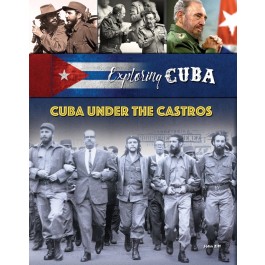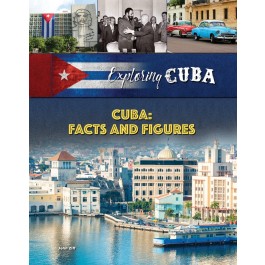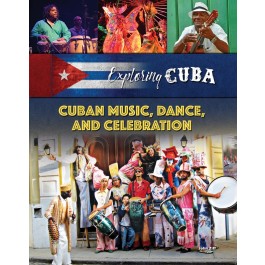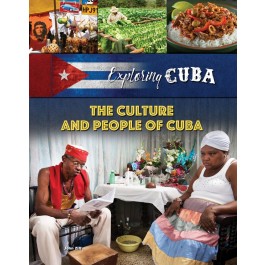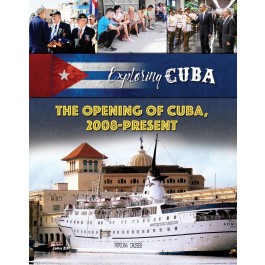EXPLORING CUBA
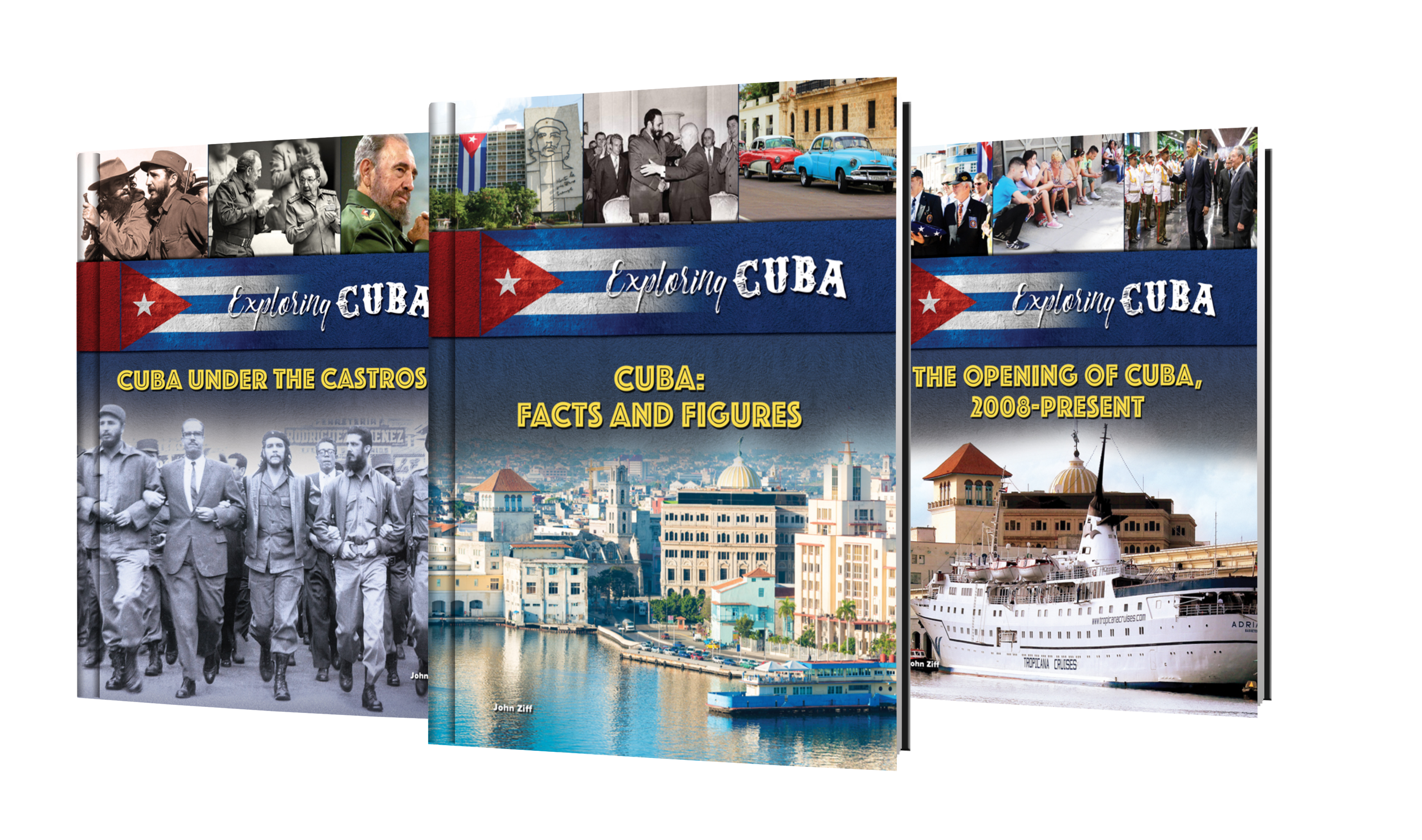
6
2018
12+
7th - 12th
7 X 9
Booklist Review
In this volume of Exploring Cuba, young readers are invited to learn about life in Cuba after Raúl Castro renewed relations with the U.S. An overview of Cuba’s political history is followed by details about the daily lives of Cubans under Fidel Castro’s reforms—both the benefits and the disadvantages. Details about the restored relations between the U.S. and Cuba explore the dramatic ways in which the lives of the people of Cuba have continued to change, from private-sector jobs to the availability of cell phones and personal computers. Photographs and illustrations enliven the sometimes text-heavy pages, and questions closing each chapter invite readers to consider the information more carefully. Though the text can be dense, the currency of the topic is appealing and should draw in students working on reports.SLJ Review
A comprehensive look at Cuba’s complex and culturally rich history. This set paints a portrait of past and contemporary Cuba, one sympathetic to the Cuban people, who have endured Spanish colonial rule, slavery, corrupt dictatorships, and the Castro brothers. Books discuss how those factors influenced Cuban culture, especially music and dance. All of the titles include summaries of Cuban history, and there is plenty of background about Cuba, its relationships with its allies and enemies, and its gains and losses in the Castro era. Clear maps, photos, and artist renderings illustrate the books. Cuba and its relationship with the United States remains a highly polarized topic and this well-written set will provide students with an in-depth look at the culture, politics, and history of the island nation. VERDICT A good choice for reports.by John Ziff
| Hardcover | ISBN 978-1-4222-3809-7 | $24.95 | Add To Cart |
| eBook | ISBN 978-1-4222-7976-2 | $31.95 | Add To Cart |
To truly understand a nation, one must know a bit about that nation’s art. What kind or subjects do its leading novelists write about? Which themes preoccupy its major poets? Who are the most popular painters and sculptors, and what do their works depict? This book examines the major currents in Cuban art and literature, from colonial times to the present. The book also tells the stories of some of the country’s most respected creative talents. These include the poet and patriot José Martí, who is beloved as “the Apostle of Cuban Independence”; the novelist Alejo Carpentier, a major figure in Latin America’s 20th-century literary “boom”; the painter Amelia Peláez del Casal, a leader of Cuba’s avant-garde art movement; and Rita Longa, whose iconic sculptures adorn the capital city of Havana. Each title in this series includes color photos throughout, and back matter including: an index and further reading lists for books and internet resources. Key Icons appear
throughout the books in this series in an effort to encourage library readers to build knowledge, gain awareness, explore possibilities and expand their viewpoints through our content rich non-fiction books. Key Icons in this series are as follows: Words to Understand are shown at the front of each chapter with definitions. These words are set in boldfaced type in that chapter, so that readers are able to reference back to the definitions--building their vocabulary and enhancing their reading comprehension. Sidebars are highlighted graphics with content rich material within that allows readers to build knowledge and broaden their perspectives by weaving together additional information to provide realistic and holistic perspectives. Educational Videos are offered in chapters through the use of a QR code, that, when scanned, takes the student to an online video showing a moment in history, a speech, or an instructional video. This gives the readers additional content to supplement the text. Text-Dependent Questions are placed at the end of each chapter. They challenge the reader’s comprehension of the chapter they have just read, while sending the reader back to the text for more careful attention to the evidence presented there. Research Projects are provided at the end of each chapter as well and provide readers with suggestions for projects that encourage deeper research and analysis. And a Series Glossary of Key Terms is included in the back matter containing terminology used throughout the series. Words found here broaden the reader’s knowledge and understanding of terms used in this field.
by John Ziff
| Hardcover | ISBN 978-1-4222-3811-0 | $24.95 | Add To Cart |
| eBook | ISBN 978-1-4222-7978-6 | $31.95 | Add To Cart |
On New Year’s Day 1959, Cuban dictator Fulgencio Batista fled the island as a revolutionary army advanced on the capital city of Havana. Exuberant celebrations erupted in Havana and elsewhere. The corrupt and repressive Batista was almost universally hated, and the leader of the revolution that unseated him had promised to bring justice, freedom, and democracy to Cuba. That leader, a charismatic young lawyer named Fidel Castro, would rule the island—aided by a small inner circle that included his brother Raúl—for the next five decades. The Castro regime could claim some undeniable achievements. It dramatically improved circumstances for the poorest Cubans. It improved and expanded public education. It created a first-rate health care system that guarantees free medical care to all citizens. But, in the view of critics—and over the years the Castros would acquire many—such achievements were more than offset by the regime’s failures. The Castro government wreaked havoc with
Cuba’s economy, stifling development and plunging the country into periodic crises. And, even worse, the Castros proved just as repressive as Fulgencio Batista had been. This book presents an overview of the controversial Castro regime. It details the government’s major actions and policies and examines what life has been like for ordinary Cubans as a result. Each title in this series includes color photos throughout, and back matter including: an index and further reading lists for books and internet resources. Key Icons appear throughout the books in this series in an effort to encourage library readers to build knowledge, gain awareness, explore possibilities and expand their viewpoints through our content rich non-fiction books. Key Icons in this series are as follows: Words to Understand are shown at the front of each chapter with definitions. These words are set in boldfaced type in that chapter, so that readers are able to reference back to the definitions--building their vocabulary and enhancing their reading comprehension. Sidebars are highlighted graphics with content rich material within that allows readers to build knowledge and broaden their perspectives by weaving together additional information to provide realistic and holistic perspectives. Educational Videos are offered in chapters through the use of a QR code, that, when scanned, takes the student to an online video showing a moment in history, a speech, or an instructional video. This gives the readers additional content to supplement the text. Text-Dependent Questions are placed at the end of each chapter. They challenge the reader’s comprehension of the chapter they have just read, while sending the reader back to the text for more careful attention to the evidence presented there. Research Projects are provided at the end of each chapter as well and provide readers with suggestions for projects that encourage deeper research and analysis. And a Series Glossary of Key Terms is included in
by John Ziff
| Hardcover | ISBN 978-1-4222-3810-3 | $24.95 | Add To Cart |
| eBook | ISBN 978-1-4222-7977-9 | $31.95 | Add To Cart |
Cuba has been much in the news recently. The 2015 restoration of diplomatic relations between Cuba and the United States generated big headlines. So, too, did the 2016 death of longtime Cuban leader Fidel Castro. Likewise, the 2017 decision by outgoing U.S. president Barack Obama to end a decades-old policy by which Cubans who reached American soil were automatically granted permanent-resident status. For readers interested in learning more about the country behind the headlines, this book is a good place to start. It offers an overview of Cuba, exploring the island’s geography, history, economy, government, people, major cities, and more. Each title in this series includes color photos throughout, and back matter including: an index and further reading lists for books and internet resources. Key Icons appear throughout the books in this series in an effort to encourage library readers to build knowledge, gain awareness, explore possibilities and expand their viewpoints through our
content rich non-fiction books. Key Icons in this series are as follows: Words to Understand are shown at the front of each chapter with definitions. These words are set in boldfaced type in that chapter, so that readers are able to reference back to the definitions--building their vocabulary and enhancing their reading comprehension. Sidebars are highlighted graphics with content rich material within that allows readers to build knowledge and broaden their perspectives by weaving together additional information to provide realistic and holistic perspectives. Educational Videos are offered in chapters through the use of a QR code, that, when scanned, takes the student to an online video showing a moment in history, a speech, or an instructional video. This gives the readers additional content to supplement the text. Text-Dependent Questions are placed at the end of each chapter. They challenge the reader’s comprehension of the chapter they have just read, while sending the reader back to the text for more careful attention to the evidence presented there. Research Projects are provided at the end of each chapter as well and provide readers with suggestions for projects that encourage deeper research and analysis. And a Series Glossary of Key Terms is included in the back matter containing terminology used throughout the series. Words found here broaden the reader’s knowledge and understanding of terms used in this field.
by John Ziff
| Hardcover | ISBN 978-1-4222-3812-7 | $24.95 | Add To Cart |
| eBook | ISBN 978-1-4222-7979-3 | $31.95 | Add To Cart |
For Cubans, it seems, music and dance are only slightly less essential to life than breathing and eating. On the Caribbean island, no one needs an excuse to dance to the rich and varied rhythms of Cuban music. This book traces the development of Cuban popular music and dance styles. It chronicles how the meeting and melding of different cultural traditions on the island—particularly Spanish and West African—created a distinctive new music called son. In turn, son would be the foundation for a host of other dance-music genres that developed in Cuba. And, as the book shows, Cuban music and dance have had a significant influence beyond the island’s shores. Each title in this series includes color photos throughout, and back matter including: an index and further reading lists for books and internet resources. Key Icons appear throughout the books in this series in an effort to encourage library readers to build knowledge, gain awareness, explore possibilities and expand their
viewpoints through our content rich non-fiction books. Key Icons in this series are as follows: Words to Understand are shown at the front of each chapter with definitions. These words are set in boldfaced type in that chapter, so that readers are able to reference back to the definitions--building their vocabulary and enhancing their reading comprehension. Sidebars are highlighted graphics with content rich material within that allows readers to build knowledge and broaden their perspectives by weaving together additional information to provide realistic and holistic perspectives. Educational Videos are offered in chapters through the use of a QR code, that, when scanned, takes the student to an online video showing a moment in history, a speech, or an instructional video. This gives the readers additional content to supplement the text. Text-Dependent Questions are placed at the end of each chapter. They challenge the reader’s comprehension of the chapter they have just read, while sending the reader back to the text for more careful attention to the evidence presented there. Research Projects are provided at the end of each chapter as well and provide readers with suggestions for projects that encourage deeper research and analysis. And a Series Glossary of Key Terms is included in the back matter containing terminology used throughout the series. Words found here broaden the reader’s knowledge and understanding of terms used in this field.
by John Ziff
| Hardcover | ISBN 978-1-4222-3813-4 | $24.95 | Add To Cart |
| eBook | ISBN 978-1-4222-7980-9 | $31.95 | Add To Cart |
To truly understand a nation, one must know a bit about that nation’s art. What kind or subjects do its leading novelists write about? Which themes preoccupy its major poets? Who are the most popular painters and sculptors, and what do their works depict? This book examines the major currents in Cuban art and literature, from colonial times to the present. The book also tells the stories of some of the country’s most respected creative talents. These include the poet and patriot José Martí, who is beloved as “the Apostle of Cuban Independence”; the novelist Alejo Carpentier, a major fi gure in Latin America’s 20th-century literary “boom”; the painter Amelia Peláez del Casal, a leader of Cuba’s avant-garde art movement; and Rita Longa, whose iconic sculptures adorn the capital city of Havana. Each title in this series includes color photos throughout, and back matter including: an index and further reading lists for books and internet resources. Key Icons appear
throughout the books in this series in an effort to encourage library readers to build knowledge, gain awareness, explore possibilities and expand their viewpoints through our content rich non-fiction books. Key Icons in this series are as follows: Words to Understand are shown at the front of each chapter with definitions. These words are set in boldfaced type in that chapter, so that readers are able to reference back to the definitions--building their vocabulary and enhancing their reading comprehension. Sidebars are highlighted graphics with content rich material within that allows readers to build knowledge and broaden their perspectives by weaving together additional information to provide realistic and holistic perspectives. Educational Videos are offered in chapters through the use of a QR code, that, when scanned, takes the student to an online video showing a moment in history, a speech, or an instructional video. This gives the readers additional content to supplement the text. Text-Dependent Questions are placed at the end of each chapter. They challenge the reader’s comprehension of the chapter they have just read, while sending the reader back to the text for more careful attention to the evidence presented there. Research Projects are provided at the end of each chapter as well and provide readers with suggestions for projects that encourage deeper research and analysis. And a Series Glossary of Key Terms is included in the back matter containing terminology used throughout the series. Words found here broaden the reader’s knowledge and understanding of terms used in this field.
by John Ziff
| Hardcover | ISBN 978-1-4222-3814-1 | $24.95 | Add To Cart |
| eBook | ISBN 978-1-4222-7981-6 | $31.95 | Add To Cart |
By the time he stepped down as Cuba’s president in 2008, Fidel Castro had been in power for half a century. During that time, for good or—as his many critics insist—for ill, Castro had completely transformed the country. Following the model of communism, he’d brought Cuba’s economy under the complete control of the state. Businesses were nationalized and private property eliminated. Citizens were prohibited from leaving the country without the government’s permission. Castro also earned the enmity of the United States, which imposed a crippling trade embargo and worked to isolate Cuba diplomatically. The years since Castro’s departure have seen significant changes. Cuban citizens are now permitted to own certain small businesses, and to buy and sell real estate. Cubans may now travel abroad. And in 2015, Cuba and the United States restored full diplomatic relations, which had been severed in 1961. Where will these and other recent changes lead? What’s in store for the
island nation and its people? What might the future hold for U.S.-Cuba relations? This book explores those questions. Each title in this series includes color photos throughout, and back matter including: an index and further reading lists for books and internet resources. Key Icons appear throughout the books in this series in an effort to encourage library readers to build knowledge, gain awareness, explore possibilities and expand their viewpoints through our content rich non-fiction books. Key Icons in this series are as follows: Words to Understand are shown at the front of each chapter with definitions. These words are set in boldfaced type in that chapter, so that readers are able to reference back to the definitions--building their vocabulary and enhancing their reading comprehension. Sidebars are highlighted graphics with content rich material within that allows readers to build knowledge and broaden their perspectives by weaving together additional information to provide realistic and holistic perspectives. Educational Videos are offered in chapters through the use of a QR code, that, when scanned, takes the student to an online video showing a moment in history, a speech, or an instructional video. This gives the readers additional content to supplement the text. Text-Dependent Questions are placed at the end of each chapter. They challenge the reader’s comprehension of the chapter they have just read, while sending the reader back to the text for more careful attention to the evidence presented there. Research Projects are provided at the end of each chapter as well and provide readers with suggestions for projects that encourage deeper research and analysis. And a Series Glossary of Key Terms is included in the back matter containing terminology used throughout the series. Words found here broaden the reader’s knowledge and understanding of terms used in this field.













